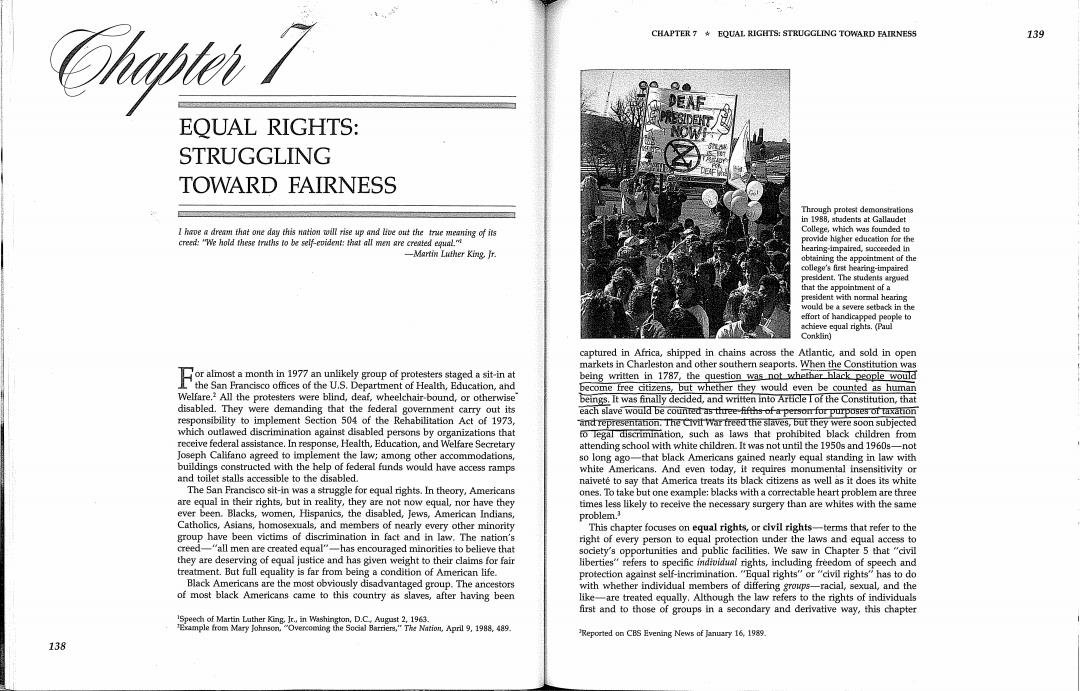
CHAPTER 7 EQUAL RIGHTS:STRUGGLING TOWARD EAIRNESS 139 EQUAL RIGHTS: STRUGGLING TOWARD FAIRNESS Through protest demonstrations in 1988,students at Gallaudet I have a dream that one day this mation will rise up and live ou the tre meaning of its College,which was founded to creed:"We hoid these truths to be self-epident:that all men are created egualm provide higher education for the -Martin Luther King Jr. obeaining the appointment of the college's first hearing-impaired president.The students argued would be a severe setback in the captured in Africa,shipped in chains across the Atlantic,and sold in open markets in Charleston and other southern seaports.When the Constitution was oralmost a month in 1977 an unlikely group of protesters staged a sit-in at being written in 1787,the question was not whether hlack people would L'the San Francisco offices of the U.S.Department of Health,Education,and become free citizens,but whether they would even be counted as human Welfare.All the protesters were blind,deaf,wheelchair-bound,or otherwise beings.It was finally decided,and written into Article I of the Constitution,that disabled.They were demanding that the federal government carry out its each slave would be counted as three fifths of a person for purposes of taxation responsibility to implement Section 504 of the Rehabilitation Act of 1973, and representahon.The Clvil War freed the slaves,but they were soon subjected which outlawed discrimination against disabled persons by organizations that fo Tegal discrimination,such as laws that prohibited black children from receive federal assistance.In response,Health,Education,and Welfare Secretary attending school with white children.It was not until the 1950s and 1960s-not Joseph Califano agreed to implement the law;among other accommodations, so long ago-that black Americans gained nearly equal standing in law with buildings constructed with the help of federal funds would have access ramps white Americans.And even today,it requires monumental insensitivity or and toilet stalls accessible to the disabled. naivete to say that America treats its black citizens as well as it does its white The San Francisco sit-in was a struggle for equal rights.In theory,Americans ones.To take but one example:blacks with a correctable heart problem are three are equal in their rights,but in reality,they are not now equal,nor have they times less likely to receive the necessary surgery than are whites with the same ever been.Blacks,women,Hispanics,the disabled,Jews,American Indians, problem. Catholics,Asians,homosexuals,and members of nearly every other minority This chapter focuses on equal rights,or eivil rights-terms that refer to the group have been victims of discrimination in fact and in law.The nation's right of every person to equal protection under the laws and equal access to creed-"all men are created equal"-has encouraged minorities to believe that society's opportunities and public facilities.We saw in Chapter 5 that"civil they are deserving of equal justice and has given weight to their claims for fair liberties"refers to specific individual rights,including freedom of speech and treatment.But full equality is far from being a condition of American life. protection against self-inerimination."Equal rights"or"civil rights"has to do Black Americans are the most obviously disadvantaged group.The ancestors with whether individual members of differing groups-racial,sexual,and the of most black Americans came to this country as slaves,after having been like-are treated equally.Although the law refers to the rights of individuals first and to those of groups in a secondary and derivative way,this chapter Reported on CBS Evening News of January 16,1989 138
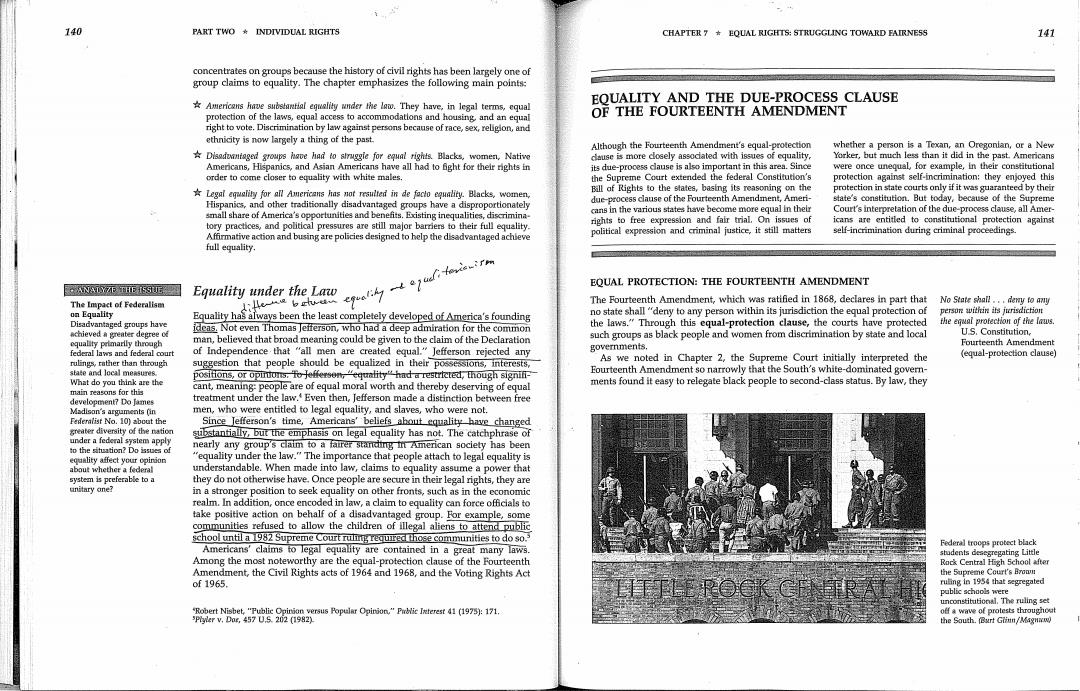
140 PART TWO INDIVIDUAL RIGHTS CHAPTER 7 EQUAL RIGHTS:STRUGGLING TOWARD FAIRNESS 141 concentrates on groups because the history of civil rights has been largely one of group claims to equality.The chapter emphasizes the following main points: Americenshavessaulityder the They have,inega terms,equal EQUALITY AND THE DUE-PROCESS CLAUSE protection of the laws,equal access to accommodatlons and housing,and an equal OF THE FOURTEENTH AMENDMENT right to vote.Discrimination by law against persons because of race,sex,religion,and ethnicity is now largely a thing of the past. Although the Fourteenth Amendment's equal-protection whether a person is a Texan,an Oregonian,or a New Disaduntaged groups have had to slruggie for equal rights.Blacks,women,Native dause is more dosely assodated with issues of equality, Yorker,but much less than it did in the past.Americans Americans,Hispanics,and Asian Americans have all had to fight for their rights in its due-process clause is also important in this area.Sinoe were once unequal,for example,in their constitutional order to come closer to equality with white males. the Supreme Court extended the federal Constitutlon's protection against self-incrimination:they enjoyed this Legal eqlity for an Americans has not resulte in de faco equty.Blackswomen, Bill of Rights to the states,basing its reasoning on the orotection in state courts only if it was guaranteed by their due-process clause of the Fourteenth Amendment,Ameri- state's constitution.But today,because of the Supreme mhonmm cans in the various states have become more equal in their Court's interpretation of the due-process clause,all Amer- gagmpsped rights to free expression and fair trial.On issues of icans are entitled to constitutional protection against political expression and criminal justice,itsi matters self-incrimination during criminal proceedings. full equality. N57币HEf5S正 EQUAL PROTECTION:THE FOURTEENTH AMENDMENT Equality under the Law The Impact of Federalism epalily op uditerieirm The Fourteenth Amendment,which was ratifed in 1868,declares in part that No State sa..demy toy on Equality Equality has always been the least completely developed of America's founding no state shall"deny to any person within its jurisdiction the equal protection of persun within its jurisdiction Disadvantaged groups have the laws."Through this equal-protection clause,the courts have protected the enmal protection of the laws achieved a greater degree od ideas.Not even Thomas Jefferson,who had a deep admiration for the common man,believed that broad meaning could be given to the claim of the Declaration such groups as black people and women from discrimination by state and local U.S.Constitution, of Independence that "all men are created equal."Jefferson rejected any governments. Fourteenth Amendment As we noted in Chapter 2,the Supreme Court initially interpreted the (equal-protection clause) rulings,rather than through suggestion that people should be equalized in their possessions,interests, state and local measures. positions,or opiuons.fo Jefferson,"equality"had a restrieted,though signin- Fourteenth Amendment so narrowly that the South's white-dominated govern- What do you thinkare the cant,meaning:people are of equal moral worth and thereby deserving of equal ments found it easy to relegate black people to second-class status.By law,they main reasons for this development?Do James treatment under the law.Even then,Jefferson made a distinction between free Madison's arguments (in men,who were entitled to legal equality,and slaves,who were not. Federalist No.10)about the Since Jefferson's time,Americans'beliefs about equality have changed substantially,but the emphasis on legal equality has not.The catchphrase of under a federal system apply to the situation?Do issues of nearly any group's claim to a fairer starding m American society has been 'equality under the law."The importance that people attach to legal equality is understandable.When made into law,claims to equality assume a power that system is preferable to a they do not otherwise have.Once people are secure in their legal rights,they are unitary ane? in a stronger position to seek equality on other fronts,such as in the economic realm.In addition,once encoded in law,a claim to equality can force officials to take positive action on behalf of a disadvantaged group.For example,some communities refused to allow the children of illegal aliens to attend public school until a 1982 Supreme Court rulig required those communities to do so.3 Americans'claims to legal equality are contained in a great many laws. Federal troops protect black students desegregating Little Among the most noteworthy are the equal-protection clause of the Fourteenth Rock Central High 5chool after Amendment,the Civil Rights acts of 1964 and 1968,and the Voting Rights Act the 5uprer me courl's of1965. ruting in 1954 that pabltc schdols were unconstitutional.The ruling set Robert Nisbet,"Public Opinion versus Popular Opinion"Ixterest 41 (1975):171 P%rV.D,457U.5202982 offa wave of protests throughout he South.®wr
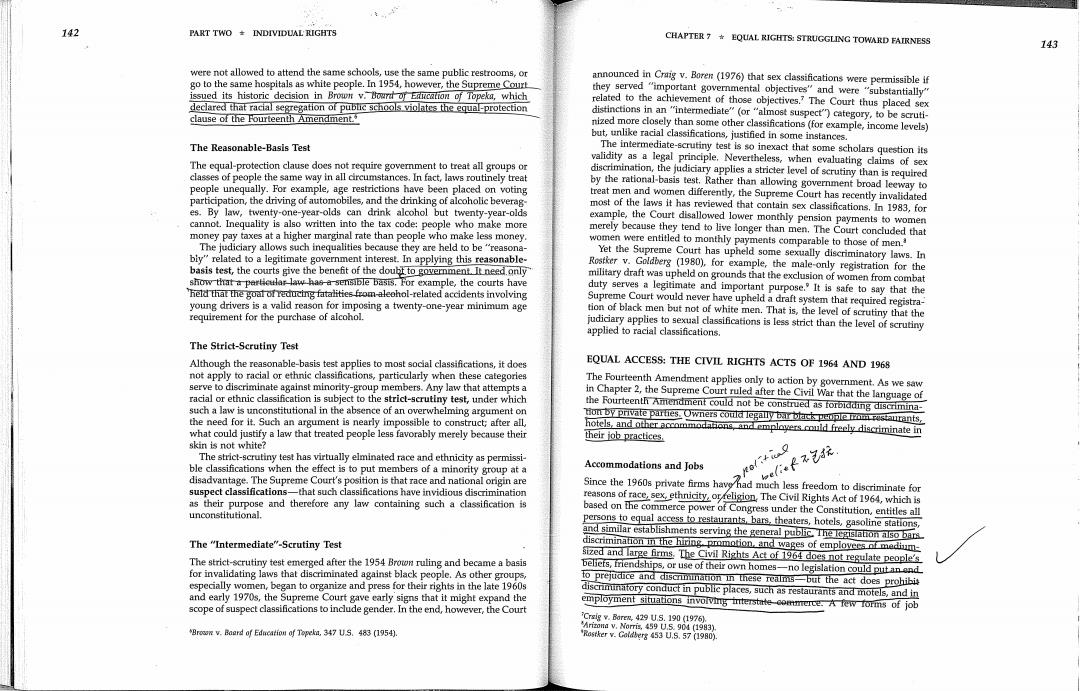
142 PART TWO INDIVIDUAL RIGHTS CHAPTER 7*EQUAL RIGHTS:STRUGGLING TOWARD FAIRNESS 143 were not allowed to attend the same schools,use the same public restrooms,or go to the same hospitals as white people.In 1954,however,the Supreme Courl announced in Crig v.Boren(1976)that sex classifications were permissible if issued its historic decision in Brown v.Bourd of Edncation of Topeka,which they served "important governmental objectives"and were "substantially" declared that racial segregation of public schools violates the equal-protection related to the achievement of those objectives.?The Court thus placed sex clause of the Fourteenth Amendment. distinctions in an"intermediate"(or"almost suspect category,to be scruti- nized more closely than some other classifications (for example,income levels) but,unlike racial classifications,justified in some instances. The Reasonable-Basis Test The intermediate-scrutiny test isso inexact that some scholars question its The equal-protection clause does not require government to treat all groups or validity as a legal principle.Nevertheless,when evaluating claims of sex classes of people the same way in all circumstances.In fact,laws routinely treat discrimination,the judiciary applies a stricter level of scrutiny than is required people unequally.For example,age restrictions have been placed on voting by the rational-basis test.Rather than allowing government broad leeway to participation,the driving of automobiles,and the drinking of alcoholic beverag- treat men and women differently,the Supreme Court has recently invalidated es.By law,twenty-one-year-olds can drink alcohol but twenty-year-olds most of the laws it has reviewed that contain sex classifications.In 1983,for cannot.Inequality is also written into the tax code:people who make more example,the Court disallowed lower monthly pension payments to women money pay taxes at a higher marginal rate than people who make less money. merely because they tend to live longer than men.The Court concluded that The judiciary allows such inequalities because they are held to be "reasona- women were entitled to monthly payments comparable to those of men. biy"related to a legitimate government interest.In applying this reasonable- Yet the Supreme Court has upheld some sexually discriminatory laws.In basis test,the courts give the benefit of the doubt to government It need.only Rostker v.Goldberg (1980),for example,the male-only registration for the show that a parteular law-has-a-sensible basis.For example,the courts have military draft was upheld on grounds that the exclusion of women from combat held that the goal of reducing fatalities from-aleohol-related accidents involving duty serves a legitimate and important purpose.It is safe to say that the young drivers is a valid reason for imposing a twenty-one-year minimum age Supreme Court would never have upheld a draft system that required registra- requirement for the purchase of alcohol. tion of black men but not of white men.That is,the level of scrutiny that the judiciary applies to sexual classifications is less strict than the level of scrutiny applied to racial classifications. The Strict-Scrutiny Test Although the reasonable-basis test applies to most social classifications,it does EQUAL ACCESS:THE CIVIL RIGHTS ACTS OF 1964 AND 1968 not apply to racial or ethnic classifications,particularly when these categories serve to discriminate against minority-group members.Any law that attempts a The Fourteenth Amendment applies only to action by government.As we saw racial or ethnic classification is subject to the strict-scrutiny test,under which in Chapter 2,the Supreme Court ruled after the Civil War that the language of such a law is unconstitutional in the absence of an overwhelming argument on the Fourteenth Amendment could not be construed as forbidding discrimina- the need for it.Such an argument is nearly impossible to construct;after all, tion by private parties.Owners could legally bar black perple trom rastaurants, what could justify a law that treated people less favorably merely because their hotels,and other accommodations,and cmplovers could frecly discriminate in their job practices. skin is not white? The strict-scrutiny test has virtually elminated race and ethnicity as permissi- ble classifications when the effect is to put members of a minority group at a Accommodations and Jobs disadvantage.The Supreme Court's position is that race and national origin are suspect classifications-that such classifications have invidious discrimination Since the 1960s private firms havy had much less freedom to discriminate for as their purpose and therefore any law containing such a elassification is reasons of race,sex,ethnicity,or feligion.The Civil Rights Act of 1964,which is unconstitutional. based on the commerce power of Congress under the Constitution,entitles all persons to equal access to restaurants,bars,theaters,hotels,gasoline stations, and similar establishments serving the general public.The legislaton also bars The "Intermediate"-Scrutiny Test discrimination in the hiring promotion,and wages of emplovees of medium- The strict-scrutiny test emerged after the 1954 Browon ruling and became a basis sized and large firms.The Civil Rights Act of 1964 does not regulate people's for invalidating laws that discriminated against black people.As other groups, beliets,friendships,or use of their own homes-no legislation could put an ond especially women,began to organize and press for their rights in the late 1960s to prejudice and discnmination in these realms-but the act does prohibis and early 1970s,the Supreme Court gave early signs that it might expand the discniminatory conduct in public places,such as restaurants and motels,and in scope of suspect classifications to include gender.In the end,however,the Court employment situations involving interstate commerce.A lew forms of job Crsig v.Bores,429 U.S.190 (1976) Brooon v.Baard of Education of Topeka,347 U.S.483 (1954)
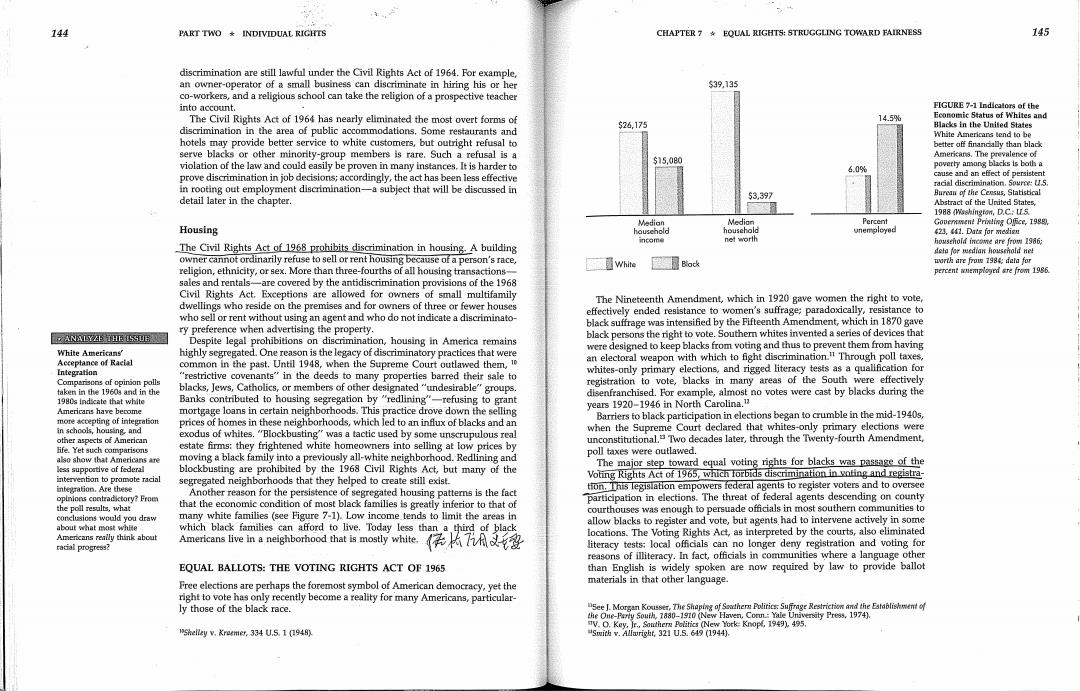
144 PART TWO女,INDIVIDUAL RIGHTS CHAPTER 7*EQUAL RIGHTS:STRUGGLING TOWARD FAIRNESS 145 discrimination are still lawful under the Civil Rights Act of 1964.For example, an owner-operator of a small business can discriminate in hiring his or her 39,135 co-workers,and a religious school can take the religion of a prospective teacher into account. FIGURE 7-1 Indicators of the The Civil Rights Act of 1964 has nearly eliminated the most overt forms of 14.5% Economic Status of Whites and 526.175 Hlacks in the United States discrimination in the area of public accommodations.Some restaurants and White Americars tend to be hotels may provide better service to white customers,but outright refusal to better off financially than black serve blacks or other minority-group members is rare.Such a refusal is a Americans.The 515.080 violation of the law and could easily be proven in many instances.It is harder to 6.0% prove discrimination in job decisions;accordingly,the act has been lesseffecive cause and an effect of persistent racial discriminabion.Sovro 5 in rooting out employment discrimination-a subject that will be discussed in detail later in the chapter. 53,397 Abstract of the United States 1988 (Wsskington,D.C:LL5. Percent Gouemment Prinling Ofce,198g) Housing 2达,4M1.Dri net worth The Civil Rights Act of 1968 prohibits discrimination in housing.A building d如or wedian househald net owner cannot ordinarily refuse to sell or rent housing because of a person's race, religion,ethnicity,or sex.More than three-fourths of all housing transactions- 勇whie 图星ak worth are froue 1984:data for sales and rentals-are covered by the antidiscrimination provisions of the 1968 Civil Rights Act.Exceptions are allowed for owners of small multifamily The Nineteenth Amendment,which in 1920 gave women the right to vote, dwellings who reside on the premises and for owners of three or fewer houses who sell or rent without using an agent and who do not indicate a discriminato- effectively ended resistance to women's suffrage;paradoxically,resistance to black suffrage was intensified by the Fifteenth Amendment,which in 1870 gave ry preference when advertising the property. [-ANIY☑STHE LSUE black persons the right to vote.Southern whites invented a series of devices that Despite legal prohibitions on discrimination,housing in America remains were designed to keep blacks from voting and thus to prevent them from having White Americans highly segregated.One reason is the legacy of discriminatory practices that were Acceptance of Racial common in the past.Until 1948,when the Supreme Court outlawed them,0 an electoral weapon with which to fight discrimination.Through poll taxes Integration whites-only primary elections,and rigged literacy tests as a qualification for 'restrictive covenants"in the deeds to many properties barred their sale to m taken in the 1960s and in the blacks,Jews,Catholics,or members of other designated "undesirable"groups. registration to vote,blacks in many areas of the South were effectively disenfranchised.For example,almost no votes were cast by blacks during the 1980s Indicate that white Banks contributed to housing segregation by "redlining"-refusing to grant Americans have become mortgage loans in certain neighborhoods.This practice drove down the selling years 1920-1946 in North Carolina.1 prices of homes in these neighborhoods,which led to an influx of blacks and an Barriers to black participation in elections began to crumble in the mid-1940s other aspects of American exodus of whites."Blockbusting"was a tactic used by some unscrupulous real when the Supreme Court declared that whites-only primary elections were estate firms:they frightened white homeowners into selling at low prices by unconstitutional Two decades later,through the Twenty-fourth Amendment, moving a black family into a previously all-white neighborhood.Redlining and poll taxes were outlawed. The major step toward equal voting rights for blacks was passage of the blockbusting are prohibited by the 1968 Civil Rights Act,but many of the intervention to pramote racial segregated neighborhoods that they helped to create still exist. Voting Rights Act of 1965,which forbids discrimination in yoting and registra inteyration.Are these Another reason for the persistence of segregated housing patterns is the fact tion.This legislation empowers federal agents to register voters and to oversee that the economic condition of most black families is greatly inferior to that of participation in elections.The threat of federal agents descending on county courthouses was enough to persuade officials in most southern communities to conclusions would you draw many white families (see Figure 7-1).Low income tends to limit the areas in which black families can afford to live.Today less than a third of black allow blacks to register and vote,but agents had to intervene actively in some about what mast whHe Americans really think about Americans live in a neighborhood that is mostly white. locations.The Voting Rights Act,as interpreted by the courts,also eliminated racial progress? literacy tests:local officials can no longer deny registration and voting for reasons of illiteracy.In fact,officials in communities where a language other EQUAL BALLOTS:THE VOTING RIGHTS ACT OF 1965 than English is widely spoken are now required by law to provide ballot Free elections are perhaps the foremost symbol of American democracy,yet the materials in that other language. right to vote has only recently become a reality for many Americans,particular- ly those of the black race. See J.Mo gan The SHa8 F 0 ersity Press,1974). ck:Knope,1949495, Shelley v.Kroemer,334 U.S.1 (1948) Swich v.right,1U..6()
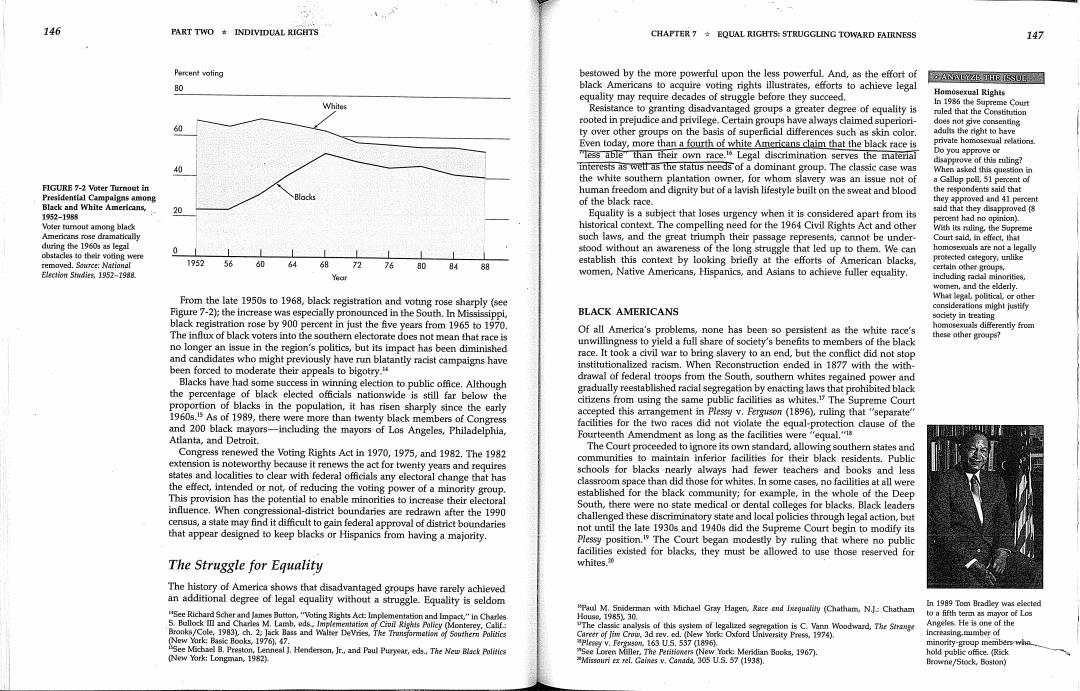
146 PART TWO INDIVIDUAL RIGHTS CHAPTER 7*EQUAL RIGHT5:STRUGGLING TOWARD EAIRNESS 147 Percent voting bestowed by the more powerful upon the less powerful.And,as the effort of AN☑生HS☑ 0 black Americans to acquire voting rights illustrates,efforts to achieve legal equality may require decades of struggle before they succeed. Homosexual Rights Whites n1985he5 Resistance to granting disadvantaged groups a greater degree of equality is upreme Court ruled that the Corstitution rooted in prejudice and privilege.Certain groups have always claimed superiori- does not give consenting 60 ty over other groups on the basis of superficial differences such as skin color. adults the rignt to have Even today,more than a fourth of white Americans claim that the black race is "Tess able"than their own race.1 Legal discrimination serves the material interests as well as the status needs of a dominant group.The classic case was disapprove of this ruling? When asked this question in the white southern plantation owner,for whom slavery was an issue not of a Gallup poll,51 percent of FIGURE 7-2 Voter Turnout in human freedom and dignity but of a lavish lifestyle built on the sweat and blood the respondents said that Presidential Campaigns among they approved and 41 percent Black and White Americans, of the black race. 20 said that they disapproved (8 1952-1985 Equality is a subject that loses urgency when it is considered apart from its nt had no pa ion) Voter tumout among black historical context.The compelling need for the 1964 Civil Rights Act and other such laws,and the great triumph their passage represents,cannot be under- Court said,in effect,that during the 1960s as legal 0 stood without an awareness of the long struggle that led up to them.We can homosexuals are not a legally obstacles to their voting were 195256606468727680 日4 88 establish this context by looking briefly at the efforts of American blacks, protected category. Election Stdies,1952-1988 women,Native Americans,Hispanics,and Asians to achieve fuller equality. certain other groups. including radal minorithes, women.and the elderly. From the late 1950s to 1968,black registration and voting rose sharply (see What legal,political,or other Figure 7-2);the increase was especially pronounced in the South.In Mississippi, BLACK AMERICANS siderabons might justify society in treating black registration rose by 900 percent in just the five years from 1965 to 1970 homesexuals differently from The influx of black voters into the southern electorate does not mean that race is Of all America's problems,none has been so persistent as the white race's unwillingness to yield a full share of society's benefits to members of the black no longer an issue in the region's politics,but its impact has been diminished and candidates who might previously have run blatantly racist campaigns have race.It took a civil war to bring slavery to an end,but the conflict did not stop been forced to moderate their appeals to bigotry." institutionalized racism.When Reconstruction ended in 1877 with the with- Blacks have had some success in winning election to public office.Although drawal of federal troops from the South,southern whites regained power and the percentage of black elected officials nationwide is still far below the gradually reestablished racial segregation by enacting laws that prohibited black proportion of blacks in the population,it has risen sharply since the early citizens from using the same public facilities as whites.1 The Supreme Court 1960s.15 As of 1989,there were more than twenty black members of Congress accepted this arrangement in Plessy v.Ferguson(1896),ruling that"separate" and 200 black mayors-including the mayors of Los Angeles,Philadelphia, facilities for the two races did not violate the equal-protection clause of the Atlanta,and Detroit. Fourteenth Amendment as long as the facilities were "equal."8 Congress renewed the Voting Rights Act in 1970,1975,and 1982.The 1982 The Court proceeded to ignore its own standard,allowing southern states and extension is noteworthy because it renews the act for twenty years and requires communities to maintain inferior facilites for their black residents.Public states and localities to clear with federal officials any electoral change that has schools for blacks nearly always had fewer teachers and books and less the effect,intended or not,of reducing the voting power of a minority group classroom space than did those for whites.In some cases,no facilities at all were This provision has the potential to enable minorities to increase their electoral established for the black community;for example,in the whole of the Deep influence.When congressional-district boundaries are redrawn after the 1990 South,there were no state medical or dental colleges for blacks.Black leaders census,a state may find it difficult to gain federal approval of district boundaries challenged these diseriminatory state and local policies through legal action,but that appear designed to keep blacks or Hispanics from having a majority. not until the late 1930s and 1940s did the Supreme Court begin to modify its Plessy position.The Court began modestly by ruling that where no public facilities existed for blacks,they must be allowed to use those reserved for The Struggle for Equality whites. The history of America shows that disadvantaged groups have rarely achieved an additional degree of legal equality without a struggle.Equality is seldom in 1989 Tom Bradley was elected uSee Richard Scher and James Button,"Voting Rights Act:Imp and Imp Paul M.Sniderman with Michael Gray Hagenace gualiy(Chatham.NJ:Chatham bo a fifth term as mavor of Los 5.Bullock II and Charles M.Lamh.eds 198530. Policy Angeles.He is one of the Brooks/Cole 19)ch.2 Bass and Walter Palitics 二益完装之满心 increasing-naumber of Pv.rg45163US.537189 nority-group members wha (New York:Longman.192) See Loren Miller,The Pefitiomers (New Yock:Meridian Books,1967). hold pablic o西e.民ick "Missouri ex rel.Gaimes v.Canada,305 U.S.57 (1938). owne/Stock.Bston)